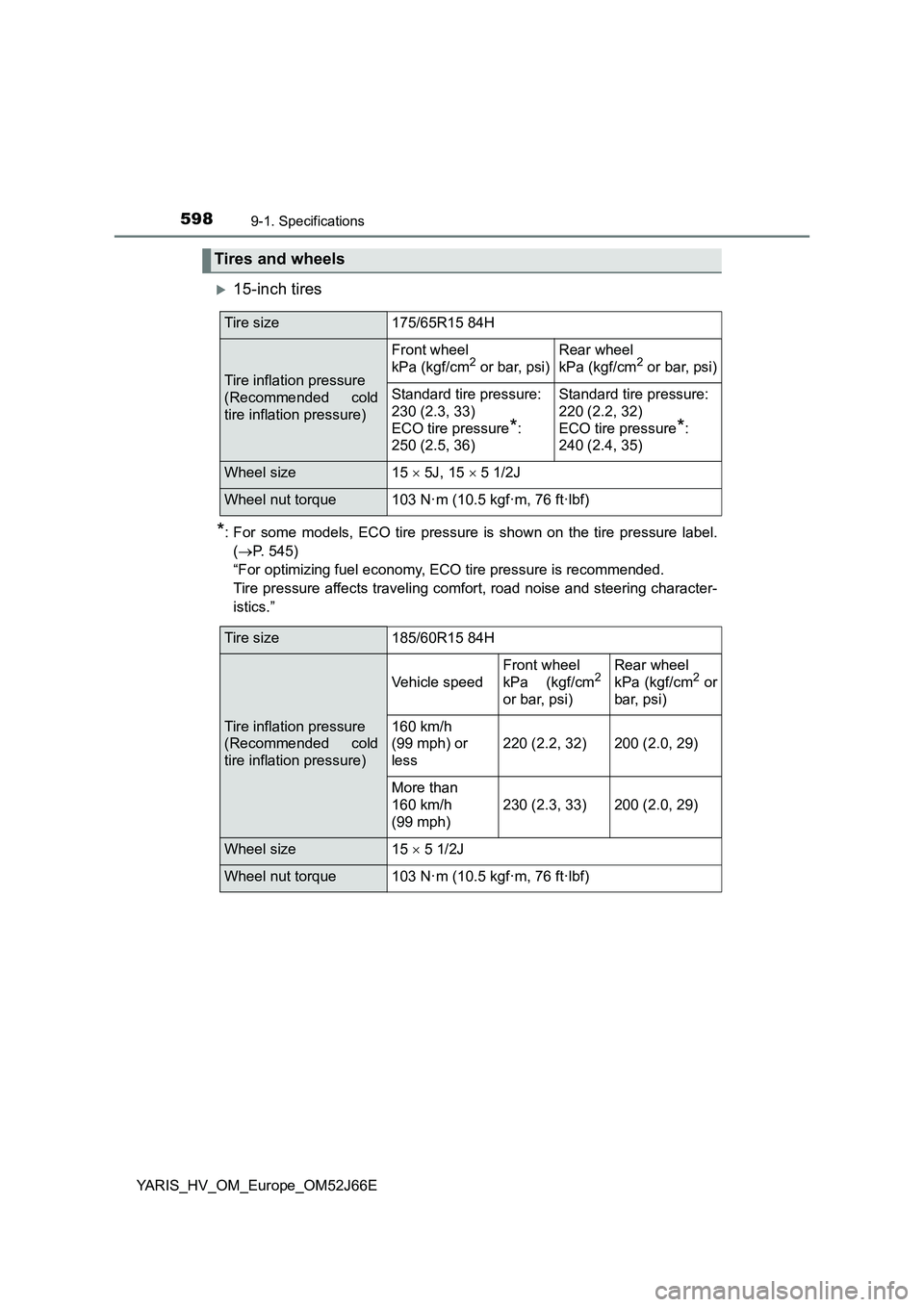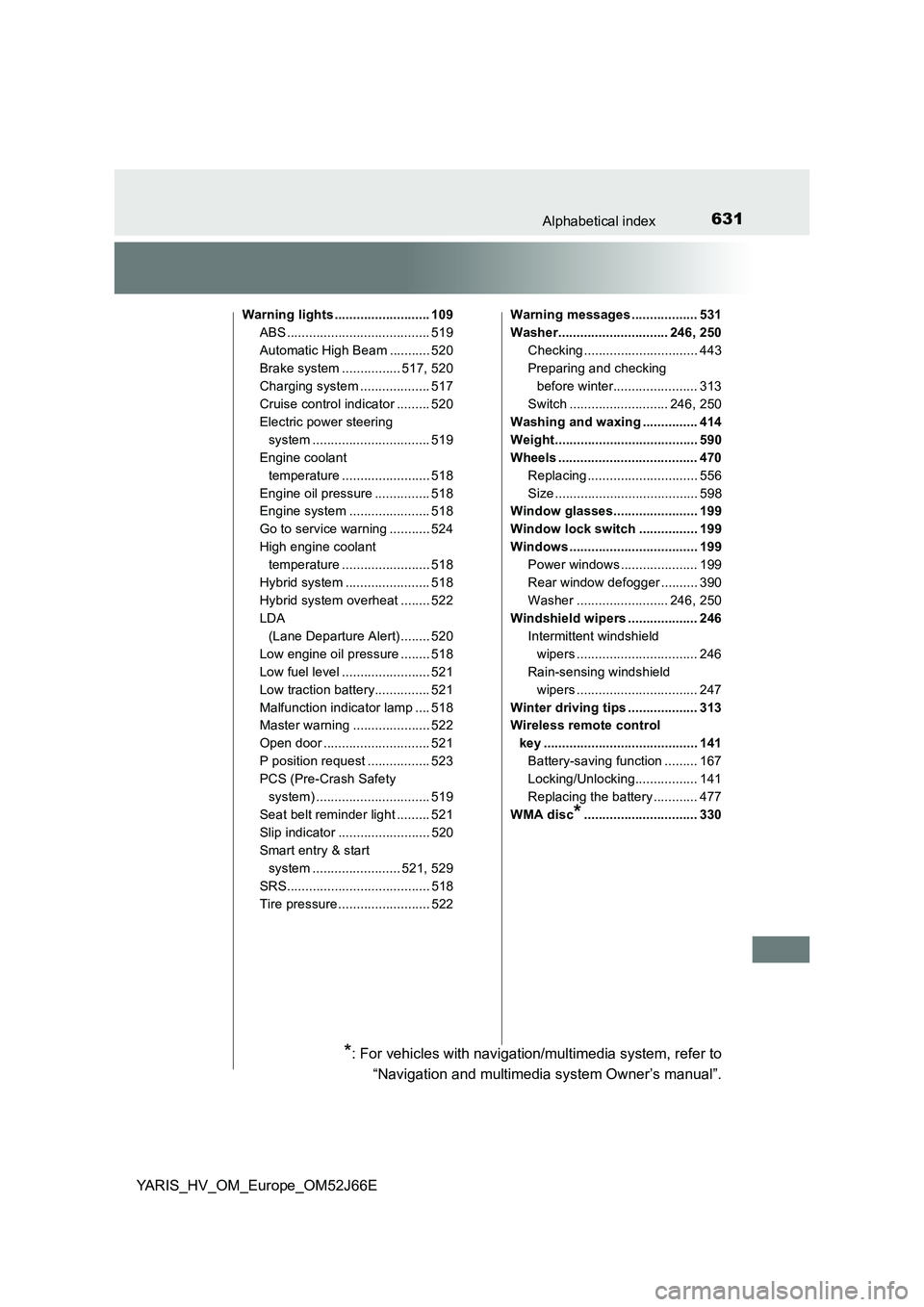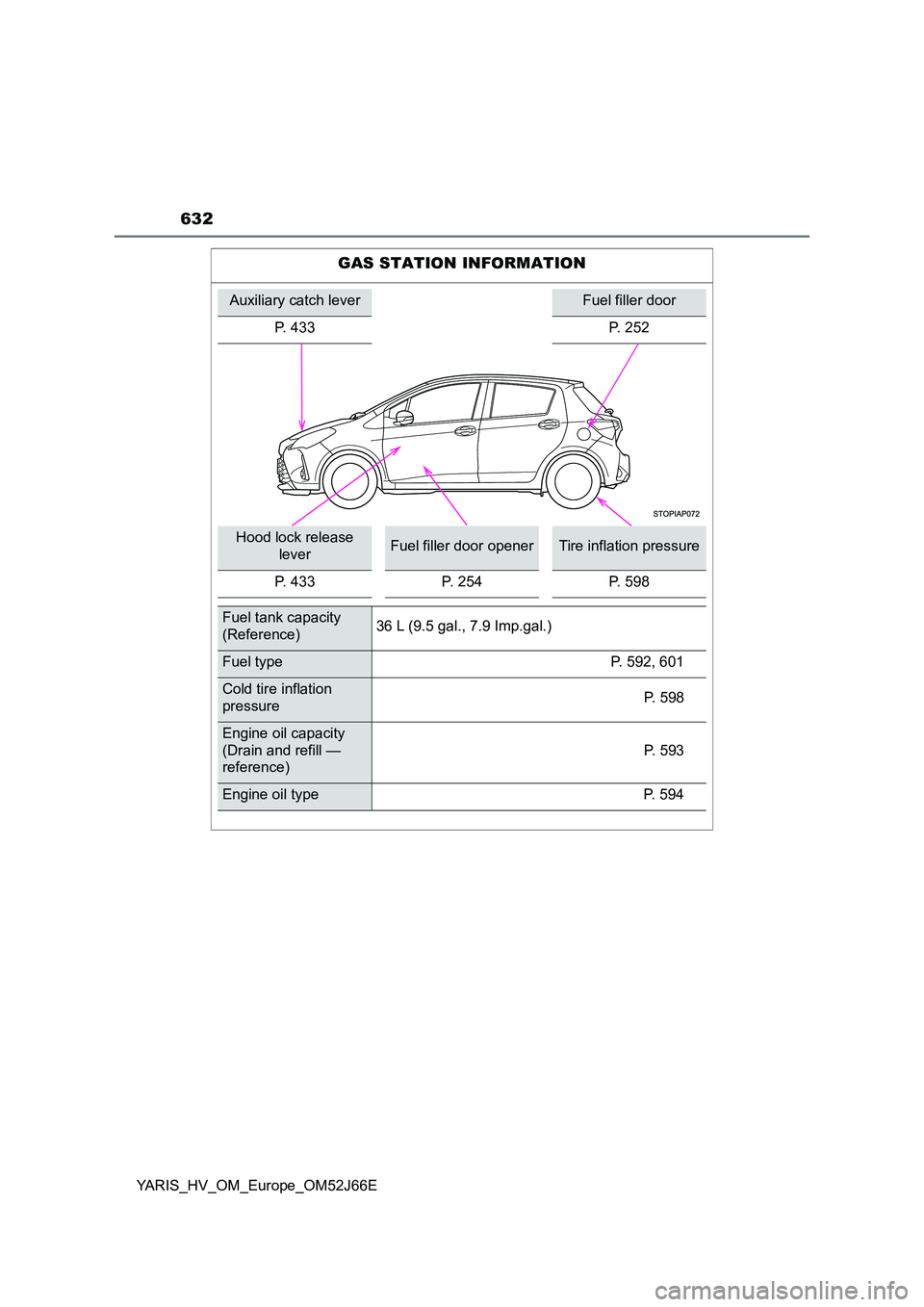2018 TOYOTA YARIS fuel pressure
[x] Cancel search: fuel pressurePage 15 of 632

15Pictorial index
YARIS_HV_OM_Europe_OM52J66E
Wipers. . . . . . . . . . . . . . . . . . . . . . . . . . . . . . . . . . . . . . . P. 246, 250
Precautions against winter season . . . . . . . . . . . . . . . . . . . . . P. 313
Precautions against car wash . . . . . . . . . . . . . . . . . . . . . . . . . P. 416
Fuel filler door . . . . . . . . . . . . . . . . . . . . . . . . . . . . . . . . . . . . P. 252
Refueling method . . . . . . . . . . . . . . . . . . . . . . . . . . . . . . . . . . P. 252
Fuel type/fuel tank capacity . . . . . . . . . . . . . . . . . . . . . . . . . . . P. 592
Tires . . . . . . . . . . . . . . . . . . . . . . . . . . . . . . . . . . . . . . . . . . . . P. 451
Tire size/inflation pressure . . . . . . . . . . . . . . . . . . . . . . . . . . . . P. 598
Winter tires/tire chain . . . . . . . . . . . . . . . . . . . . . . . . . . . . . . . . P. 313
Checking/rotation/tire pressure warning system*3 . . . . . . . . . P. 451
Coping with flat tires . . . . . . . . . . . . . . . . . . . . . . . . . . . . P. 537, 556
Hood . . . . . . . . . . . . . . . . . . . . . . . . . . . . . . . . . . . . . . . . . . . . P. 433
Opening . . . . . . . . . . . . . . . . . . . . . . . . . . . . . . . . . . . . . . . . . . P. 433
Engine oil . . . . . . . . . . . . . . . . . . . . . . . . . . . . . . . . . . . . . . . . . P. 593
Coping with overheat . . . . . . . . . . . . . . . . . . . . . . . . . . . . . . . . P. 581
Headlights/front position lights/daytime running lights/
front turn signal lights . . . . . . . . . . . . . . . . . . . . . . . . . P. 236, 238
Front fog lights*3. . . . . . . . . . . . . . . . . . . . . . . . . . . . . . . . . . P. 244
Side turn signal lights . . . . . . . . . . . . . . . . . . . . . . . . . . . . . . P. 236
Rear turn signal lights. . . . . . . . . . . . . . . . . . . . . . . . . . . . . . P. 236
Back-up lights/tail lights (LED type) . . . . . . . . . . . . . . . . . . P. 238
Shifting the shift lever to R. . . . . . . . . . . . . . . . . . . . . . . . . . . . P. 232
Stop/tail lights . . . . . . . . . . . . . . . . . . . . . . . . . . . . . . . . . . . . P. 238
Rear fog light . . . . . . . . . . . . . . . . . . . . . . . . . . . . . . . . . . . . . P. 244
License plate lights . . . . . . . . . . . . . . . . . . . . . . . . . . . . . . . . P. 238
4
5
6
7
Light bulbs of the exterior lights for driving
(Replacing method: P. 486, Watts: P. 600)
*1: Vehicles with a smart entry & start system
*2: Vehicles with monochrome display
*3: If equipped
8
9
10
11
12
13
14
15
Page 110 of 632

1102. Instrument cluster
YARIS_HV_OM_Europe_OM52J66E
*1: These lights turn on when the power switch is turned to the “ON” position
(vehicles without a smart entry & start system) or ON mode (vehicles with
a smart entry & start system) to indicate that a system check is being per-
formed. They will turn off after the hybrid system on, or after a few sec-
onds. There may be a malfunction in a system if a light does not come on,
or if the lights do not turn off. Have the vehicle inspected by any authorized
Toyota retailer or Toyota authorized repairer, or any reliable repairer.
*2: If equipped
*3: The light turns on to indicate a malfunction.
*4: The light flashes in yellow to indicate a malfunction. The light flashes
quickly in green to indicate that the steering lock has not been released.
*5: The light illuminate on the center panel.
*6: The light flashes to indicate a malfunction.
*7: The lights turn on with LDA indicator to indicate a malfunction.
*8: Vehicles with monochrome display
*9: Vehicles with color display
*10: The light illuminates on the multi-information display.
*1, 8
Low traction battery
warning light ( P. 521)
*1, 2
Tire pressure warning
light ( P. 522)
*8
Open door warning light
( P. 521)
*1, 9
Master warning light
( P. 522)
Low fuel level warning
light ( P. 521)
*1, 8
Hybrid system overheat
warning light ( P. 522)
Driver’s and front
passenger’s seat belt
reminder light ( P. 521)
*1, 8
P position request
warning light ( P. 523)
*5Rear passenger’s seat
belt reminder lights
( P. 521)
*3, 8
Go to service warning
light ( P. 524)
Page 312 of 632

3124-7. Driving tips
YARIS_HV_OM_Europe_OM52J66E
◆Air conditioning
Use the air conditioning only when necessary. Doing so can help
reduce excessive gasoline consumption.
In summer: When the ambient temperature is high, use the recircu-
lated air mode. Doing so will help to reduce the burden on the air
conditioning system and reduce fuel consumption as well.
In winter: Because the gasoline engine will not automatically cut out
until it and the interior of the vehicle are warm, it will consume fuel.
Also, fuel consumption can be improved by avoiding overuse of the
heater.
◆Checking tire inflation pressure
Make sure to check the tire inflation pressure frequently. Improper
tire inflation pressure can cause poor fuel economy.
Also, as snow tires can cause large amounts of friction, their use on
dry roads can lead to poor fuel economy. Use tires that are appro-
priate for the season.
◆Luggage
Carrying heavy luggage will lead to poor fuel economy. Avoid carry-
ing unnecessary luggage. Installing a large roof rack will also cause
poor fuel economy.
◆Warming up before driving
Since the gasoline engine starts up and cuts out automatically
when cold, warming up the engine is unnecessary. Moreover, fre-
quently driving short distances will cause the engine to repeatedly
warm up, which can lead to excess fuel consumption.
Page 415 of 632

4157-1. Maintenance and care
7
Maintenance and care
YARIS_HV_OM_Europe_OM52J66E
■Automatic car washes
● Fold the mirrors and remove the antenna before washing the vehicle. Start
washing from the front of the vehicle. Make sure to re-install the antenna
and extend the mirrors before driving.
● Brushes used in automatic car washes may scratch the vehicle surface and
harm your vehicle’s paint.
● Rear spoiler (if equipped) may not be washable in some automatic car
washes. There may also be an increased risk of damage to vehicle.
■ High pressure car washes
● Do not allow the nozzles of the car wash to come within close proximity of
the windows and door borders, and high mounted stoplight.
● Before using the car wash, check that the fuel filler door on your vehicle is
closed properly.
■ When using a car wash (vehicles with a smart entry & start system
equipped with entry function)
If the door handle becomes wet while the electronic key is within the effective
range, the door may lock and unlock repeatedly. Place the key in a position
2 m (6 ft.) or more separate from the vehicle while the vehicle is being
washed. (Take care to ensure that the key is not stolen.)
■ Aluminum wheels (if equipped)
● Remove any dirt immediately by using a neutral detergent.
● Wash detergent off with water immediately after use.
● To protect the paint from damage, make sure to observe the following pre-
cautions.
• Do not use acidic, alkaline or abrasive detergent
• Do not use hard brushes
• Do not use detergent on the wheels when they are hot, such as after driv-
ing or parking in hot weather
■ Bumpers
Do not scrub with abrasive cleaners.
Page 468 of 632

4687-3. Do-it-yourself maintenance
YARIS_HV_OM_Europe_OM52J66E
Tire inflation pressure
■Effects of incorrect tire inflation pressure
Driving with incorrect tire inflation pressure may result in the following:
● Reduced fuel economy
● Reduced driving comfort and poor handling
● Reduced tire life due to wear
● Reduced safety
● Damage to the drive train
If a tire needs frequent inflating, have it checked by any authorized Toyota
retailer or Toyota authorized repairer, or any reliable repairer.
■ Instructions for checking tire inflation pressure
When checking tire inflation pressure, observe the following:
● Check only when the tires are cold.
If your vehicle has been parked for at least 3 hours or has not been driven
for more than 1.5 km or 1 mile, you will get an accurate cold tire inflation
pressure reading.
● Always use a tire pressure gauge.
It is difficult to judge if a tire is properly inflated based only on its appear-
ance.
● It is normal for the tire inflation pressure to be higher after driving as heat is
generated in the tire. Do not reduce tire inflation pressure after driving.
Make sure to maintain proper tire inflation pressure. Tire infla-
tion pressure should be checked at least once per month. How-
ever, Toyota recommends that tire inflation pressure be checked
once every two weeks. ( P. 598)
Page 598 of 632

5989-1. Specifications
YARIS_HV_OM_Europe_OM52J66E
15-inch tires
*: For some models, ECO tire pressure is shown on the tire pressure label.
( P. 545)
“For optimizing fuel economy, ECO tire pressure is recommended.
Tire pressure affects traveling comfort, road noise and steering character-
istics.”
Tires and wheels
Tire size175/65R15 84H
Tire inflation pressure
(Recommended cold
tire inflation pressure)
Front wheel
kPa (kgf/cm2 or bar, psi)
Rear wheel
kPa (kgf/cm2 or bar, psi)
Standard tire pressure:
230 (2.3, 33)
ECO tire pressure*:
250 (2.5, 36)
Standard tire pressure:
220 (2.2, 32)
ECO tire pressure*:
240 (2.4, 35)
Wheel size15 5J, 15 5 1/2J
Wheel nut torque103 N·m (10.5 kgf·m, 76 ft·lbf)
Tire size185/60R15 84H
Tire inflation pressure
(Recommended cold
tire inflation pressure)
Vehicle speed
Front wheel
kPa (kgf/cm2
or bar, psi)
Rear wheel
kPa (kgf/cm2 or
bar, psi)
160 km/h
(99 mph) or
less
220 (2.2, 32)200 (2.0, 29)
More than
160 km/h
(99 mph)
230 (2.3, 33)200 (2.0, 29)
Wheel size15 5 1/2J
Wheel nut torque103 N·m (10.5 kgf·m, 76 ft·lbf)
Page 631 of 632

631Alphabetical index
YARIS_HV_OM_Europe_OM52J66E
Warning lights .......................... 109
ABS ....................................... 519
Automatic High Beam ........... 520
Brake system ................ 517, 520
Charging system ................... 517
Cruise control indicator ......... 520
Electric power steering
system ................................ 519
Engine coolant
temperature ........................ 518
Engine oil pressure ............... 518
Engine system ...................... 518
Go to service warning ........... 524
High engine coolant
temperature ........................ 518
Hybrid system ....................... 518
Hybrid system overheat ........ 522
LDA
(Lane Departure Alert) ........ 520
Low engine oil pressure ........ 518
Low fuel level ........................ 521
Low traction battery............... 521
Malfunction indicator lamp .... 518
Master warning ..................... 522
Open door ............................. 521
P position request ................. 523
PCS (Pre-Crash Safety
system) ............................... 519
Seat belt reminder light ......... 521
Slip indicator ......................... 520
Smart entry & start
system ........................ 521, 529
SRS....................................... 518
Tire pressure ......................... 522
Warning messages .................. 531
Washer.............................. 246, 250
Checking ............................... 443
Preparing and checking
before winter....................... 313
Switch ........................... 246, 250
Washing and waxing ............... 414
Weight....................................... 590
Wheels ...................................... 470
Replacing .............................. 556
Size ....................................... 598
Window glasses....................... 199
Window lock switch ................ 199
Windows ................................... 199
Power windows ..................... 199
Rear window defogger .......... 390
Washer ......................... 246, 250
Windshield wipers ................... 246
Intermittent windshield
wipers ................................. 246
Rain-sensing windshield
wipers ................................. 247
Winter driving tips ................... 313
Wireless remote control
key .......................................... 141
Battery-saving function ......... 167
Locking/Unlocking................. 141
Replacing the battery ............ 477
WMA disc*............................... 330
*: For vehicles with navigation/multimedia system, refer to
“Navigation and multimedia system Owner’s manual”.
Page 632 of 632

632
YARIS_HV_OM_Europe_OM52J66E
GAS STATION INFORMATION
Auxiliary catch leverFuel filler door
P. 433 P. 252
Hood lock release
leverFuel filler door openerTire inflation pressure
P. 433 P. 254 P. 598
Fuel tank capacity
(Reference) 36 L (9.5 gal., 7.9 Imp.gal.)
Fuel type P. 592, 601
Cold tire inflation
pressure P. 598
Engine oil capacity
(Drain and refill —
reference)
P. 593
Engine oil type P. 594